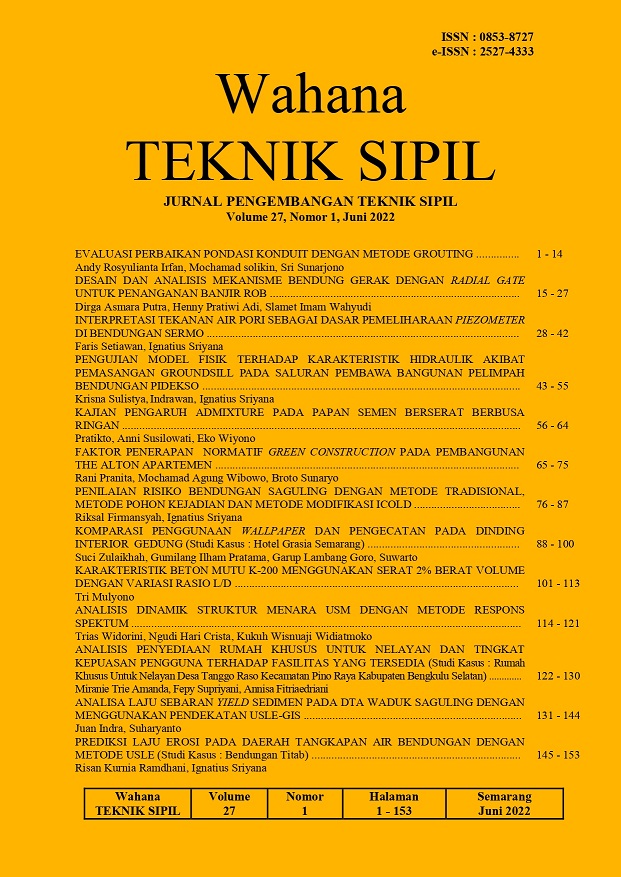INTERPRETASI TEKANAN AIR PORI SEBAGAI DASAR PEMELIHARAAN PIEZOMETER DI BENDUNGAN SERMO
DOI:
https://doi.org/10.32497/wahanats.v27i1.3669Keywords:
pore water pressure, piezometer evaluation, maintenance priorityAbstract
Pore water pressure readings (piezometer readings) produce data that must be interpreted before being used for further analysis. This process is very influential on the results of the analysis because in the piezometer reading there is the possibility of anomalies due to potential delays or lags or errors in readings. The purpose and objective of this research is to provide an alternative approach to dam safety instrumentation inventory in order to be able to arrange maintenance work properly, effective and efficient, in conditions of limited budget can be used as a standard in making decisions in prioritizing piezometer maintenance. Several piezometer data processing methods can use techniques, including : interpretation of pore water pressure patterns; correlation simulation of pore pressure values and flow line plots. The results of the research on the piezometer at the Sermo Dam can be distinguished between conditions that have good pore water pressure readings and the opposite condition, with a ratio of 71,43% and 28,57%.References
US Army Corps of Engineers, 2004, General Design and Construction Consideration for Earth and Rockfill Dams. Washington DC: US Army Corps of Engineers.
Zhani, R. F., Djamaluddin, Bakri, H., 2015, Analisis Kestabilan Lereng Menggunakan Data VWP (Vibrating Wire Piezometer) pada PT. Newmont Nusa Tenggara Barat. Jurnal Geomine, Volume 2, Agustus 2015, 100”“107. https://doi.org/10.33536/jg.v2i1.31.
Central Water Commission, 2018, Manual for Rehabilitation of Large Dams. New Delhi: India Goverment.
Santosa, B., Suprapto, H., & Suryadi, H.S., 1998, Mekanika Tanah Lanjutan. Jakarta : Gunadarma, 1-3; 15-29; 45; 50-53 p.
Claydon, J.R., Stevens, I.M., Moffat, A.I.B., Tyler, N., 1990, The Embankment Dam. In Six Conference of The Bristish Dam Society. Nottingham, England. https://www.icevirtuallibrary.com/doi/book/10.1680/ted.16477.
Subiyanti, H., Rifa”™i, A., & Jayadi, R., 2011, Analisis Kelongsoran Lereng Akibat Pengaruh Tekanan Air Pori di Saluran Induk Kalibawang Kulonprogo. Semesta Teknika, 14(1), 15”“25. https://doi.org/10.18196/st.v14i1.566.
Huda, A. L., Wardani, S. P. R., & Suharyanto, 2019, Evaluasi Tekanan Air Pori dan Rembesan pada Bendungan Panohan. Jurnal Ilmiah Teknik Sipil Dan Teknik Kimia, 4(2), 102-111. http://dx.doi.org/10.33366/rekabuana.v4i2.1372.
Foster, M., Fell, R., & Spannagle, M., 2000, The Statistics Of Embankment Dam Failures And Accidents. Kanada : Canadian Geotechnical Journal, 37(5), 1000-1024. https://doi.org/10.1139/t00-030.
Sari, U. C., Wardani, S. P. R., Suharyanto, & Partono, W., 2016, Analisis Tekanan Air Pori Menggunakan Metode Elemen Hingga Dengan Pemodelan Mohr-Coulomb pada Plaxis. Konferensi Nasional Teknik Sipil 10, 675”“683. ISBN: 978-602-60286-0-0.
Prasad, R., & Dixit, M., 2019, Instrumentation and Monitoring of Dams and Reservoirs. International Journal of Engineering and Applied Sciences, 6(10), 63-67.
Najoan, T. F., & Soetjiono, C., 2004, Pedoman Instrumentasi Tubuh Bendungan Tipe Urugan dan Tanggul. Jakarta : Departemen Permukiman dan Prasarana Wilayah.
Direktorat Jenderal Sumber Daya Air, 2003, Pedoman Operasi, Pemeliharaan dan Pengamatan Bendungan (Bagian 3 : Sistem Instrumentasi dan Pemantauan).
Wahana TEKNIK SIPIL Vol. 27 No. 1 Juni 2022 28 - 42
Indra, E. A., & Legono, D., 2005, Evaluasi Hasil Pengamatan Instrumentasi dan Prioritas Pemeliharaannya Sebagai Bagian dari Pengelolaan Keamanan Bendungan : Studi Kasus Bendungan Sermo. PhD Thesis. Universitas Gadjah Mada.
ICOLD, 1980, Deterioration of Dams And Reservoirs. Examples And Their Analysis. ICOLD, Paris. Balkema, Rotterdam.
Habibie, S. A., Djumanto, & Rustadi, 2015, Penggunaan Otolit Untuk Penentuan Umur Dan Waktu Pemijahan Ikan Red Devil, Amphilophus Labiatus [Günther, 1864] Di Waduk Sermo, Yogyakarta. Jurnal Iktiologi Indonesia, 15(2):87-98. https://doi.org/10.32491/jii.v15i2.63.
Direktorat Jenderal Sumber Daya Air, 1994, Laporan Ringkas Waduk Sermo. BBWS Serayu Opak, Yogyakarta.
Direktorat Jenderal Sumber Daya Air, 2018, Laporan Operasi dan Pemeliharaan Bendungan Sermo. BBWS Serayu Opak, Yogyakarta.
Federal Emergency Management Agency, 2015, Evaluation and Monitoring of Seepage and Internal Erosion. Interagency Committee on Dam Safety (ICODS) FEMA P-1032.
Sugiyono, 2007, Statistika untuk Penelitian. Alfabeta Bandung ISBN : 978-979-8433-10-8.
Downloads
Published
Issue
Section
License
Authors who publish with this journal agree to the following terms:Authors retain copyright and grant the journal right of first publication with the work simultaneously licensed under a Creative Commons Attribution License that allows others to share the work with an acknowledgement of the work's authorship and initial publication in this journal.
Authors are able to enter into separate, additional contractual arrangements for the non-exclusive distribution of the journal's published version of the work (e.g., post it to an institutional repository or publish it in a book), with an acknowledgement of its initial publication in this journal.
Authors are permitted and encouraged to post their work online (e.g., in institutional repositories or on their website) prior to and during the submission process, as it can lead to productive exchanges, as well as earlier and greater citation of published work (See The Effect of Open Access).






